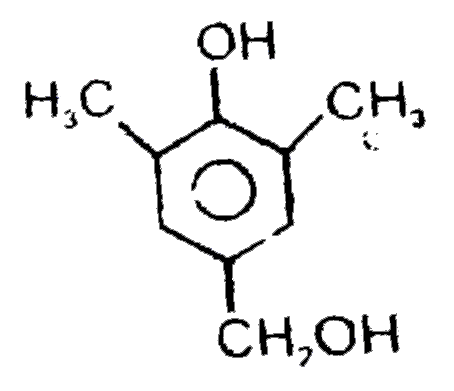The following reaction is known as :
Phenol 1.CHCl3/NaOH−−−−−−−−−−→ Salicylaldehyde
Gattermann aldehyde synthesis
Duff reaction
Perkin reaction
Reimer - Tiemann reaction
The correct Answer is:D
To determine the name of the reaction where phenol is converted to salicylaldehyde using chloroform and sodium hydroxide, we can follow these steps:
Step 1: Identify the Reactants and Products
- Reactant: Phenol (C6H5OH)
- Product: Salicylaldehyde (C6H4(OH)CHO)
Step 2: Recognize the Reagents Used
- The reagents used in the reaction are chloroform (CHCl3) and sodium hydroxide (NaOH).
Step 3: Understand the Reaction Mechanism
- The reaction involves the formation of a carbene intermediate from chloroform in the presence of a strong base (NaOH). This carbene then reacts with phenol to form salicylaldehyde.
Step 4: Identify the Type of Reaction
- This reaction is specifically known as the Riemann-Tiemann reaction. It is characterized by the conversion of phenol to salicylaldehyde using chloroform and a base.
Step 5: Eliminate Other Options
- Gatterman-Aldehyde Synthesis: Involves the formation of benzaldehyde using HCl and AlCl3.
- Duff Reaction: Converts phenol to benzaldehyde using a different reagent.
- Perkin Reaction: Involves the reaction of an aldehyde with an acid anhydride in the presence of a base.
Conclusion
The reaction of phenol to salicylaldehyde using chloroform and NaOH is known as the Riemann-Tiemann reaction.
---
- Reactant: Phenol (C6H5OH)
- Product: Salicylaldehyde (C6H4(OH)CHO)
- The reagents used in the reaction are chloroform (CHCl3) and sodium hydroxide (NaOH).
- The reaction involves the formation of a carbene intermediate from chloroform in the presence of a strong base (NaOH). This carbene then reacts with phenol to form salicylaldehyde.
- This reaction is specifically known as the Riemann-Tiemann reaction. It is characterized by the conversion of phenol to salicylaldehyde using chloroform and a base.
- Gatterman-Aldehyde Synthesis: Involves the formation of benzaldehyde using HCl and AlCl3.
- Duff Reaction: Converts phenol to benzaldehyde using a different reagent.
- Perkin Reaction: Involves the reaction of an aldehyde with an acid anhydride in the presence of a base.
The reaction of phenol to salicylaldehyde using chloroform and NaOH is known as the Riemann-Tiemann reaction.
Similar Questions
Knowledge Check
The product/ s of the following reaction is/are:
 (i)CHCl3+NaOH1Δ−−−−−−−−−−−−−→(ii)H⊕(iii)conc.NaOH(excess)1Δ−−−−−−−−−−−−−−−−−−→(iv)H⊕ (product/s)A
(i)CHCl3+NaOH1Δ−−−−−−−−−−−−−→(ii)H⊕(iii)conc.NaOH(excess)1Δ−−−−−−−−−−−−−−−−−−→(iv)H⊕ (product/s)A B
B C
C D
D
The major product obtained in the following reaction is :
 (i)CHCl3/KOH−−−−−−−−−−→(ii)Pd/C/H2A
(i)CHCl3/KOH−−−−−−−−−−→(ii)Pd/C/H2A B
B C
C D
D
Complete the following reaction :
CH3COONa+NaOHCaO−−→ACH3COONa+NaOHCaO−−→NaOHBCH3COONa+NaOHCaO−−→CH3COOH+Ca(OH)2CCH3COONa+NaOHCaO−−→CH4+Na2CO3DCH3COONa+NaOHCaO−−→CH3COOCa+NaOH
Give the structures of A,B and C in the following reactions :
(i) CH3BrKCN−−→ALiAlH4−−−→BHNO2−−−−−−→273KC
(ii) CH3COOHNH3−−−−−→ΔABr2+KOH−−−−−−→BCHCl3+NaOH−−−−−−−−−→C
(iii) CH3CNH2O/OH−−−−−−−→ANH3−−−−−→ΔBBr2+KOH−−−−−−→C
View SolutionComplete the following reactions :
(a) CHCl3+2HZn,HCl−−−−→ (b) CCl4+H2O→
(c) CHI3+CH3NH2+3KOH→ (d) CH3CH2OH+I2+NaOH→
(e) CHCl3+O2Sunlight−−−−→
View SolutionChlorobenzene Reaction−−−−→XPhenolReaction−−−−→Y
Salicylaldehyde X and Y reaction respectively are
View SolutionThe product of following reaction is:
_2019_CBT4_E01_007_Q01.png) H2SO4(Cat.)−−−−−−−−→CHCl3
H2SO4(Cat.)−−−−−−−−→CHCl3
View SolutionIdentify the product Z in the following sequence of reactions
"phenolNaOH−−−→XCO2−−−−−−−−→4−7atm,410KYH3O+−−−→Z
View Solution

